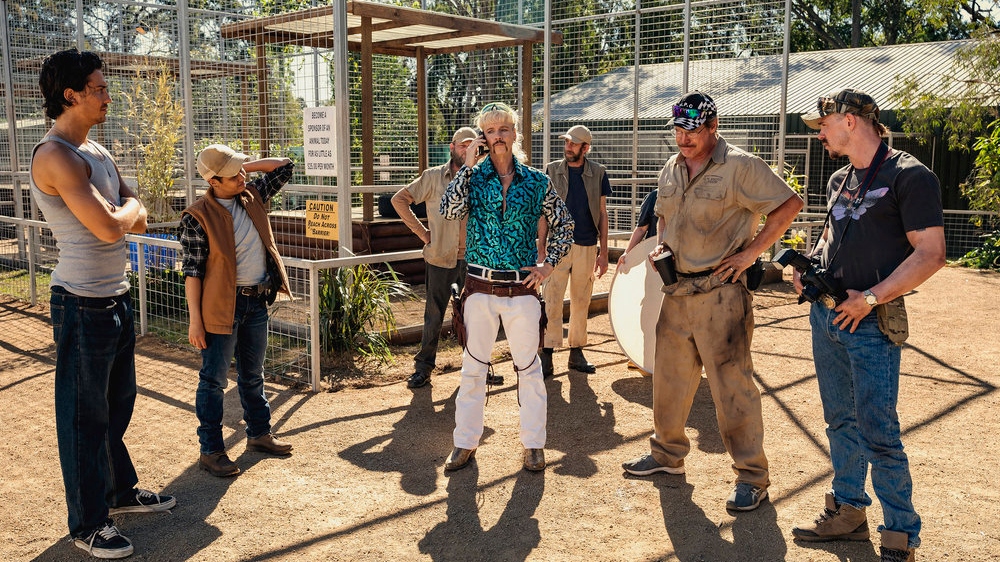
Back in March 2020, when our stay-at-home enforcement left us looking for something to divert our attention and anxieties, the personal feud between Joe Schreibvogel (aka Joe Exotic) and Carole Baskin made a welcome entrance into the zeitgeist. Their dirty dealings for big cat sanctuary were put on public display when reporter/host Robert Moor aired 15 episodes of the Wondery podcast Joe vs. Carole. The visual component of this real-life soap opera was catnip to Netflix, which found such success with its Tiger King documentary that it ordered a second season of the show.
For a variety of reasons, this wild story continues to capture the public’s imagination, and the latest chapter in this sordid saga is the arrival of Peacock’s eight-part limited series Joe vs. Carole, which is based on the hit podcast. The show finally premiered earlier this month, and once again it pits these two colorful characters and their big personalities against each other. In one corner is Joe, the tattooed, gun-toting Oklahoma big cat park owner, while in the other stands the woman he’s accused of trying to murder — animal rights activist Baskin, the CEO of Big Cat Rescue.
Cinematographer Jules O’Loughlin, who shot James Cameron’s Deep Sea Challenge and the upcoming Ms. Marvel series, had a mantra during the Joe vs. Carole shoot, which was to make it practical and real, but not so real that you felt like you were watching a documentary, as that had already been done before.
The Australian-born O’Loughlin had the luxury of shooting the series in his homeland, which doubled for both Oklahoma and Florida. However, he jokes that he might as well have been in London, as the distance between the set in Brisbane and his home in Sydney didn’t exactly lend itself to a roll-out-of-bed commute. When principal photography began in 2021, O’Loughlin surmised that Covid concerns may have brought the shoot Down Under, as Australia was considered fairly safe at the time. It turns out the production was already heading there to shoot in areas around Queensland, Australia, including Screen Queensland Studios.
Below the Line spoke with O’Loughlin via Zoom on a rainy, overcast day in Sydney. The dreary weather had no effect on the jovial DP, who lightheartedly discussed the series’ color palette, the tricks he used when shooting with CGI — Spoiler Alert: There were no real tigers in the series — and how he achieved a practical look without sacrificing any of the drama of the story. Please enjoy our chat below.
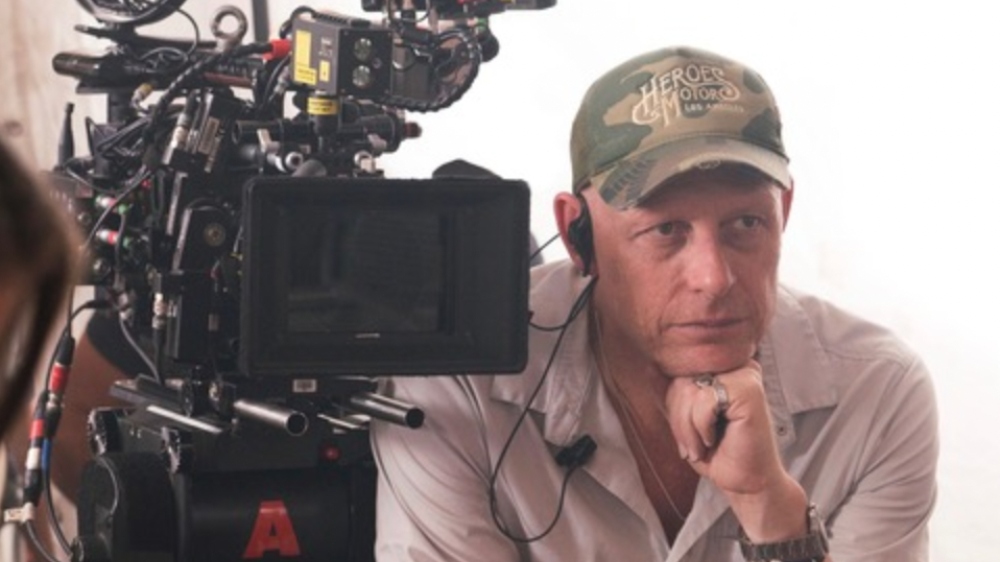
Below The Line: Was shooting in Australia part of the attraction for you in working on Joe vs. Carole?
Jules O’Loughlin: I haven’t shot drama in Australia since 2013. All of the drama that I have done in the last eight or nine years has been overseas. My home is here in Sydney and my children are here, and it was my daughter Indiana’s final year at school and I thought, ‘if I’m in Brisbane, I can fly home every weekend and be with her.’ A week after I started the job in Brisbane, the Queensland government shut the borders to New South Wales to keep Covid away. I could travel home to Sydney, but I wasn’t allowed to come back to Queensland, so I wasn’t able to go home until after the show had finished. But it was great to work on drama here with an Australian crew for the first time in years. It was a lot of fun.
BTL: What are some of the challenges you face in shooting scenes that call for a lot of CGI effects?
O’Loughlin: There are a couple of logistical challenges with it, and it’s more to do with time and the impact it had on the day. While we didn’t work with real tigers, we worked with proxies. So instead of a tiger, we would have a Great Dane, and instead of the tiger cubs, we would have cats. So [the show] was working with real animals, [but] the dogs and cats were the only animals we were allowed to work with. We had to use a dog proxy for the sheep in one of the scenes. So if you’re working with a Great Dane, there was no terror on the side of the operators being in the cages with the dogs.
It really comes down to a logistical thing because if the camera is outside the cage, where the actor is on one side of the cage and the tiger is on the other, we can have the camera in the cage looking through the cage at the actor, which is not being replaced, but if we jump to the actor’s side where we’re looking into the cage at the tiger, then we have to remove the cage front because that creates a really difficult problem for our CGI friends, to create a tiger behind the latticework of the cages.
Joe and Carole’s zoos were on the same property, [so] there were a lot of cages and there were big wide shots where we would see maybe 15 cages with 20 tigers, and so all of those cage fronts had to be removed.
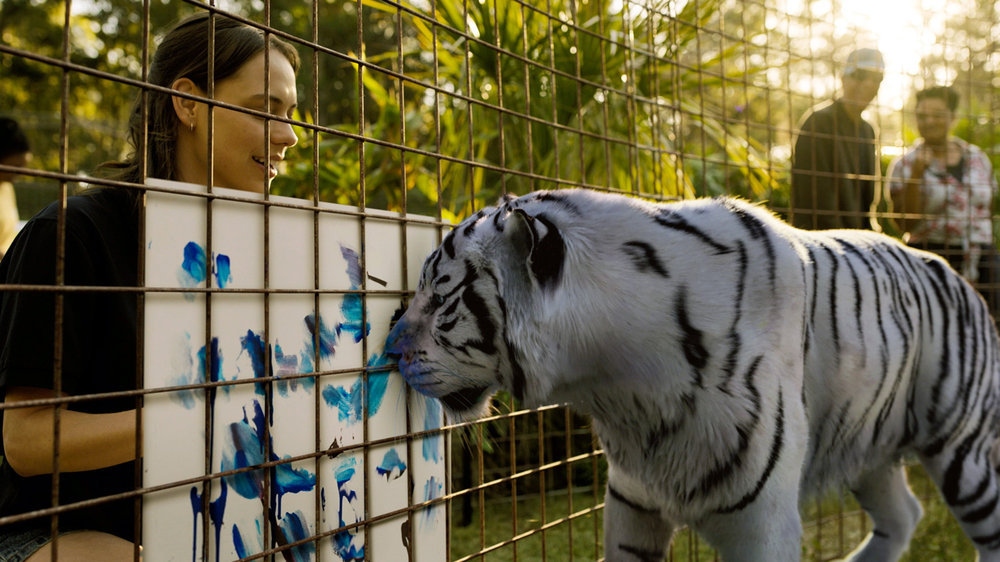
BTL: Speaking of the tigers, it seems as if the color palette of the series was modeled on their coats.
O’Loughlin: Tobacco was the major color for the present time, which was kind of 2010-2018, and then the flashbacks. That tobacco came from the tigers, where the orange shifted into a more tobacco [color], which fed into the production design as well as lighting it. We wanted to give it a distinct look. We wanted to shift it away from the documentary. which is kind of a shock as it is. We did want to give a color treatment to the show to elevate the documentary experience that many viewers would have had and to make it its own thing. In the flashbacks, we wanted to go cooler with Joe so we leaned into blues, and for Carole, kind of a rose-colored tint.
BTL: Did you watch the documentary prior to shooting?
O’Loughlin: I was in Thailand shooting Ms. Marvel when I got this script. I knew about Tiger King but I hadn’t seen it with the 100 million other people during Covid lockdown. I was kind of familiar with the story, but I read the script and loved it. What I loved were these people who were really f**ked-up human beings, but had all this humanity to them. Joe, being the stand-out, was like a human train smash, but the flip side was he had this really warm side. He became really attached to his tigers and all the people in his life, and I loved the complex characters in the script.
BTL: Who did you work most closely with on the camera design?
O’Loughlin: I interviewed with the set-up director Justin Tipping, and I loved his take on the show. We hit it off immediately. For me, as a cinematographer, it’s always script and story that comes first, but the second thing that’s almost as important is [that] the director be a collaborator who can bring what I just read on the page to life. The director is someone I’m gonna have a great creative experience with, and I knew Justin was that person.
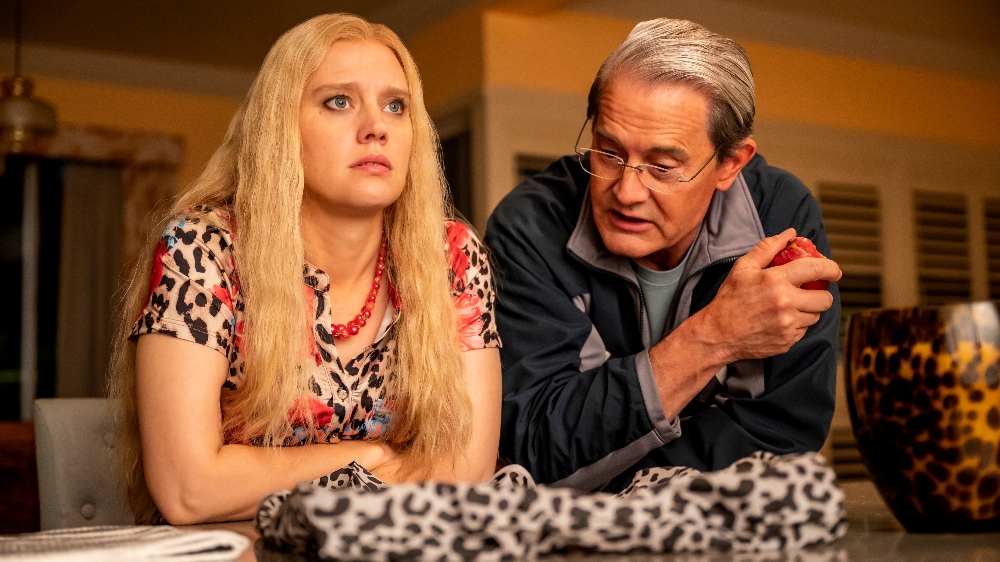
BTL: How did your visions mesh with each other?
O’Loughlin: From the get-go, he wanted to elevate this material and step away from the documentary. For a new audience, we’ve gotta grab them straight away and take them on a ride. It’s about immersing the audience without making them aware of the process. Interestingly, with my conversations with Justin, I wanted to lean into some things and break the fourth wall for argument’s sake when the character is reacting with the camera. With this show, it felt right to push the envelope with transitions from modern-day to present-day back to flashbacks.
BTL: How did you differentiate between the time periods?
O’Loughlin: We built rigs that would literally spin the camera like the world turned upside down. We’d roll out of present-day and we would roll into a flashback. We used a robotic arm called The Bolt, where we put a high-speed camera on that and it could repeat its moves. We could do quite incredible precision moves. Shooting with a high-speed camera, we could grab those moves and have a very overt, exciting camera move, which lends to the story.
BTL: What were some of the lighting techniques you used to illuminate the show?
O’Loughlin: The motivation for the lights was, it had to be practical. There are moments where there are dream sequences, for instance, when Joe is in the courtroom and he’s imagining these theatrical moments. For that, anything goes. But overall, it had to feel practical, sourced from a window, let’s say, or from a practical lamp. I worked closely with Michael Rumpf, the production designer, where we wanted a ceiling on every set. Everything had to feel as though it was based in reality. So, for instance, when Carole is on her bed with her laptop, you want to feel a sense of moonlight, but predominantly, it’s the laptop that’s lighting her. Of course, on the face of the laptop, I had a little LED panel lighting her. There were day scenes and there were night scenes, which we would shoot during the day, but I would light for the night. On the actual locations, which were Joe Exotic’s zoo and Carole’s Big Cat Rescue, I’d have to get big overhead softboxes in and light for night, which was effectively my moonlight, and use practicals as well.
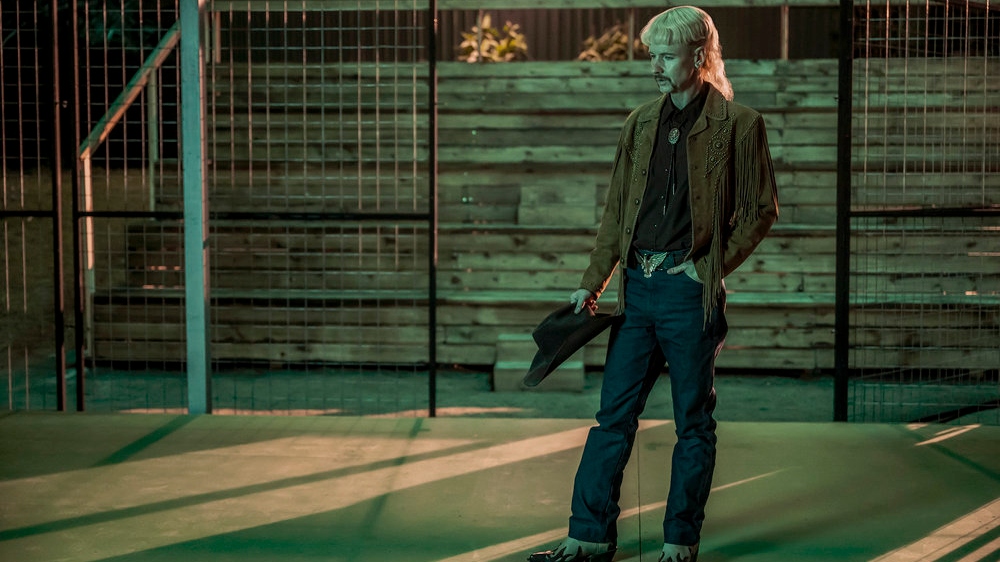
BTL: What other camera and lensing tricks did you use to highlight the central characters of Joe and Carole?
O’Loughlin: Joe is a very erratic and spontaneous character and he can turn on a dime, so the camera movement was all hand-held and Steadicam. With lenses, I wanted to differentiate between the two characters. To that end, I chose different lenses. For all of Joe’s work, I chose an anamorphic lens, which gives a very different feel to your normal spherical lenses. The reason was, we spoke about westerns and how we would shoot Joe where they used anamorphic to shoot those movies. The image tends to go soft on the sides and out-of-focus areas are more impressionistic.
For Carole, who is threaded very tightly and much more of an A-type personality and much more controlled, we used [a] studio kind of setup with all tracks and locked-off shots. I shot on rehoused Canon FD lenses, which are kind of still photographic lenses from the 70s. Their out-of-focus areas have more of a traditional photographic feel and a slightly different color rendition to them as well. Those two camera arcs cross over in Episode 7, when Joe decides he’s gonna kill Carole, and he becomes much more precise, and Carole, who knows that someone is hunting her, starts to become more discombobulated, and so she becomes hand-held and Joe becomes more locked off.
When the two characters come together in Episode 8 and their worlds collide in the courtroom, I used Arri Supreme modern spherical glass, but with a creamy kind of old-world cinematic feel with [a] laser-focused track and dolly.
BTL: Any final impressions from your overall experience on Joe vs. Carole?
O’Loughlin: Working with John [Cameron Mitchell], Kate [McKinnon], and Kyle MacLachlan was super easy, and a dream come true for a cinematographer. It was an amazing experience. I had an incredible crew, two amazing directors (Tipping and Natalie Bailey), and really supportive showrunners (executive producer Etan Frankel). I hope this brings the story to a new audience, and [that] the audience that was familiar with the story was taken on a ride.
Joe vs. Carole is currently streaming on Peacock.





